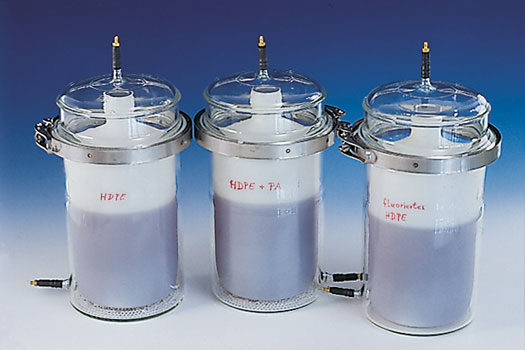
Permeation analysis

We measure the barrier effects of polymers and coatings to the permeation of gases and volatile substances.
How we explore the processes of permeation and diffusion

We determine kinetic and thermodynamic parameters (diffusion and partition coefficients) for material transport in and through polymers and composite materials such as coated paper and cardboard. Using our in-depth expertise we build automated permeation test equipment that covers a wide temperature range to address specific issues. By developing simulation models we are able to transfer our measurement data to other materials and applications such as paper/cardboard packaging, pharmaceutical and medical products, skin models, contact materials for drinking water, and containers for technical products.
Permeability of packaging materials and packagings to water vapor and oxygen
- Water vapor permeability according to DIN 53 122-1
Gravimetric determination of the amount of water vapor which permeates through a specimen under defined conditions.
- Water vapor permeability according to DIN EN ISO 15106-3
Determination of the amount of water vapor which permeates through a packaging material under defined conditions using an electrolytic cell. Lower measuring limit: 0.01 g/(m² d).
- Oxygen permeability of packaging materials according to DIN 53 380 Part 3
Carrier gas method to measure the amount of oxygen which permeates through a packaging material using an electrochemical sensor.
- Oxygen permeability of packagings according to DIN 53 380 Part 3
Carrier gas method to measure the amount of oxygen which permeates through a packaging using an electrochemical sensor.

Permeability of packaging materials and packagings to other gases
- Gas permeability (manometric method) to DIN 53 380-2
Determination of the amount of gas which permeates through a packaging material under defined conditions by measurement of the pressure variation in the permeation cell.
Gases (standard): CO2, N2, He
Other gases are also possible.
Permeability of packaging materials and other materials to organic substances
- Permeation measurements for organic substances, aroma substances, medical active substances and other chemicals
Permeation measurements through any plastic combinations or other materials (e.g. food packagings, fuel tanks etc.). Permeation measurements as a function of the organic substance and the material structure. Automated measuring devices for 15 measuring stations.
- Barrier effect of barrier layers against mineral oil
Permeation measurement for representative substances trough films (barrier + non-barrier) and coated cartons.
- Permeation measurements for gases (O2, N2, H2, CO2, SO2, NH3,...)
Permeation measurements for gases through any plastic combinations or other materials (e.g. food packagings, seals, pressure pipes, etc.): Non-destructive measurements for gases (e.g. CO2) through packagings (e.g. drink bottles, blister packages)
Gas permeation kinetics
- Permanent gas analysis and gas permeation kinetics
Analysis of gas compositions in packages and time dependent changes. Determination of the gas permeability of packagings (e.g. MAP modified atmosphere packaging); leakage tests on packaging; weak point analysis; analysis of oxygen consumption by the contents of packagings; headspace gas analysis.
 Fraunhofer Institute for Process Engineering and Packaging IVV
Fraunhofer Institute for Process Engineering and Packaging IVV